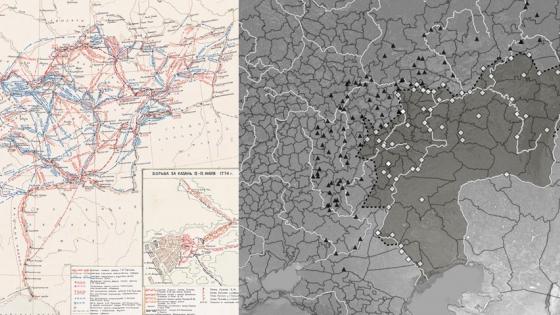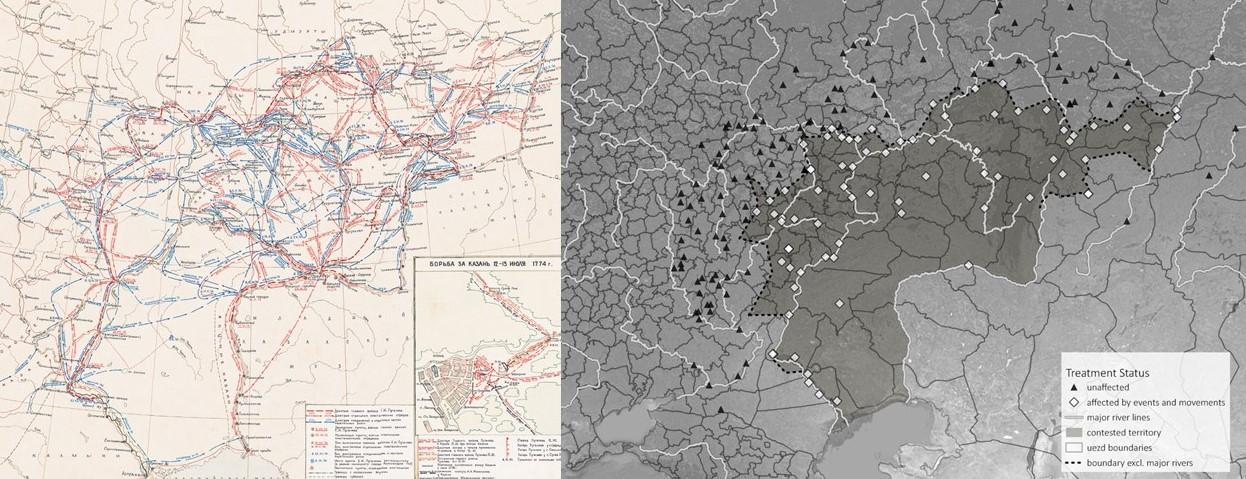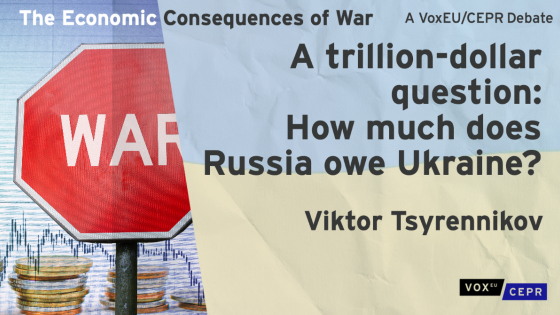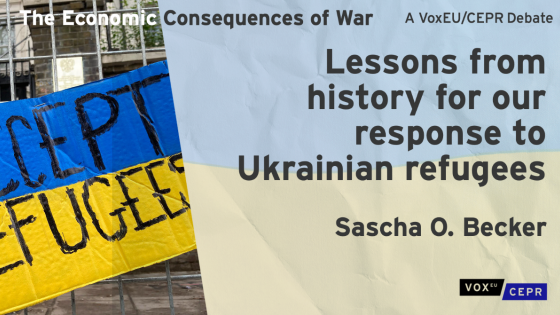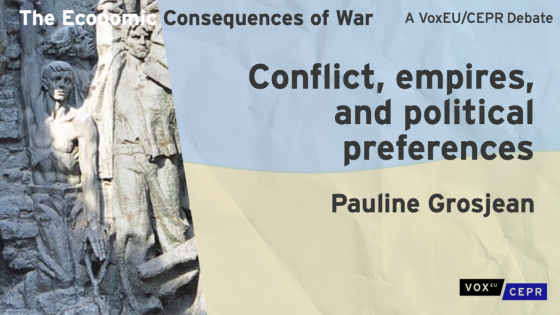A large body of research connects the impact of state capacity to the existence of a monopoly on violence, to efficient taxation and economic growth (e.g. Besley and Persson 2011, Becker et al. 2016, Dell et al. 2018, Besley 2020). However, strong states may not cater their development efforts towards regions and individuals that need them most (e.g. North and Thomas 1973, Tilly 1992).
Assessing the local impact of state capacity on economic growth is both an important and challenging question because an expansion in the size of the state within an already existing country is unlikely to be random. Often, the expansion of the state is driven by its proximity to the national ruler’s historical seat of power: the centralised growth of the French state from Paris is a classic example (Weber 1976).
The aftermath of Yemelyan Pugachev’s rebellion
In a recent study (Asmus and Franck 2022), we analyse the impact of state capacity on local economic development in the long run by exploiting a quasi-natural experiment in the regional expansion of the state.1 We focus on the aftermath of Yemelyan Pugachev’s rebellion in Russia. A Cossack from the Don region, Pugachev succeeded in controlling an extensive territory in the Southern Urals between 1773 and 1775 with a loose alliance of Cossacks, peasants, and religious traditionalists (Dubrovin 1884, Golubtsov 1926, Raeff 1970). After putting down Pugachev’s rebellion at great human cost, Empress Catherine II (r. 1762–1796) sought to prevent another uprising in the Southern Urals by implementing reforms that modern research in political economy would identify as features of strong state capacity. Inside the territory that the rebels had managed to seize, she bolstered the presence of the Russian state by increasing the numbers of military installations and civil administrators to ensure the implementation of her administrative reforms and to efficiently levy taxes (Alexander 1966, Avrich 1972). Figure 1 displays the movements of the rebels and the army as well as the boundary of the rebellion.
Figure 1
Our analysis assesses the causal impact of state capacity at the local level by exploiting the regional discontinuity created by the boundary of the rebel-held territory. This approach compares economic outcomes in areas just inside the territory exposed to increased state presence to those that were not, and evaluates effects at the boundary. In so doing, the empirical analysis can assess two aspects of strong state capacity.2 First, it can assess whether a change in local state capacity is not only conducive to the development of a state apparatus characterised by a higher number of civil servants, policemen, and soldiers, as well as by greater fiscal capacity, but also whether it enables a rise in human capital and the development of industrial and service sectors. Second, because the change in state capacity occurred in one country, this analysis can assess the local effects of national top-down policies implemented by the central state. Examples of such policies include the educational programs of Alexander II (r. 1855–1881) in the mid-1860s and the Soviet policies of forced collectivisation that sought to develop state-owned farms and factories (Gregory 1994, Davies 1998).
The effects of increased state capacity in the Southern Urals
Our analysis suggests that a change in local state capacity has limited effects on economic growth on its own, but that it fosters the central government’s development objectives at the regional level. Namely, our results show that under the Russian Empire, the local increase in state capacity was conducive to the development and persistence of activities provided by the very nature of the state, such as national security and public infrastructure. For instance, in 1910, the municipal debt of towns in formerly rebel-held areas was seven times greater. The positive effects of increased state capacity as proxied by public infrastructure persist to this day in the form of more roads, more railway stops, and more school buildings.
Nevertheless, increased state capacity did not differentially affect local human capital formation until a national political commitment to improve the provision of education was in place from the 1860s onward. Moreover, during the interwar period, the pre-existing local state capacity developed by the imperial regime shaped Soviet economic policies. When Soviet leaders sought to foster small private enterprises, places within the boundary of Pugachev’s rebellion experienced relatively higher numbers of self-employed individuals within family households. Later, when they implemented policies of forced collectivisation, the area witnessed a larger increase in the number of collective farms and forced labour camps. Namely, Stalin’s policies of agricultural and industrial collectivisation led to the establishment of one additional state-owned farm every 100 km2 inside the formerly rebel-held area, and one additional camp of forced labour every 200 km2. However, in the absence of relevant public policies, historical state capacity in the Southern Urals neither prevented the present decline in industrial employment nor enabled the rise of a service sector. In fact, individuals currently living inside the formerly rebel-held area are poorer and less educated than those living just outside of it.
References
Acemoglu, D (2005), “Politics and economics in weak and strong states”, Journal of Monetary Economics 52 (7): 1199–1226.
Alexander, J T (1966), “The Russian Government and Pugachev’s Revolt, 1773–1775”, PhD diss., Indiana University.
Asmus, G and R Franck (2022), “State Capacity, National Economic Policies and Local Economic Development: The Russian State in the Southern Urals”, CEPR Discussion Paper 17103.
Avrich, P (1972), Russian Rebels 1600–1800, New York: Norton & Company.
Bardhan, P (2016), “State and development: the need for a reappraisal of the current literature”, Journal of Economic Literature 54 (3): 862–892.
Becker, S O (2022), “Lessons from history for our response to Ukrainian refugees”, VoxEU.org, 29 March.
Becker, S O, K Boeckh, C Hainz and L Woessmann (2016), “The empire is dead, long live the empire! Long run persistence of trust and corruption in the bureaucracy”, Economic Journal 126 (590): 40–74.
Besley, T (2020), “State capacity, reciprocity, and the social contract”, Econometrica 88 (4): 1307–1335.
Besley, T and T Persson (2011), Pillars of prosperity: the political economics of development clusters, Princeton University Press.
Davies, R (1998), Soviet economic development from Lenin to Khrushchev, Cambridge University Press.
Dell, M, N Lane, and P Querubin (2018), “The historical state, local collective action, and economic development in Vietnam”, Econometrica 86 (6): 2083–2121.
Dubrovin, N F (1884), Pugachev I Ego Soobshchniki, Volume 2, Charleston, SC: Nabu Press.
Gennaioli, N and H J Voth (2015), “State capacity and military conflict” Review of Economic Studies 82 (4): 1409¬–1448.
Golubtsov, S A (1926), Pugachevshchina, Volume 1, Moscow, RU: Gosudarstvennoe Izdatel’stvo.
Gregory, P R (1994), Before command: an economic history of Russia from emancipation to the first five-year, Princeton University Press.
Grosjean, P (2022), “Conflict, empires, and political preferences”, VoxEU.org, 28 March.
Harrison, M (2017), “The Soviet economy, 1917–1991: its life and afterlife”, The Independent Review 22 (2): 199–206.
Raeff, M (1970), “Pugachev’s rebellion”, in Preconditions of Revolution in Early Modern Europe, The Johns Hopkins University Press.
Rohner, D and M Thoenig (2021), “The elusive peace dividend of development policy: from war traps to macro-complementarities”, Annual Review of Economics 13, 111–131.
Weber, E (1976), From peasants to Frenchmen: the modernization of rural France 1870–1914, Stanford University Press.
Endnotes
1 Such an approach differs from other studies focusing on the effects of historical state capacity by examining the border of a historical state within a modern country.
2 Our main outcomes are not confounded by a potential catch-up effect that regions may experience in the wake of an economic response of the state to war and destruction. For recent discussions on the economic consequences of war, see Rohner and Thoenig (2021), Becker (2022), and Grosjean (2022).
